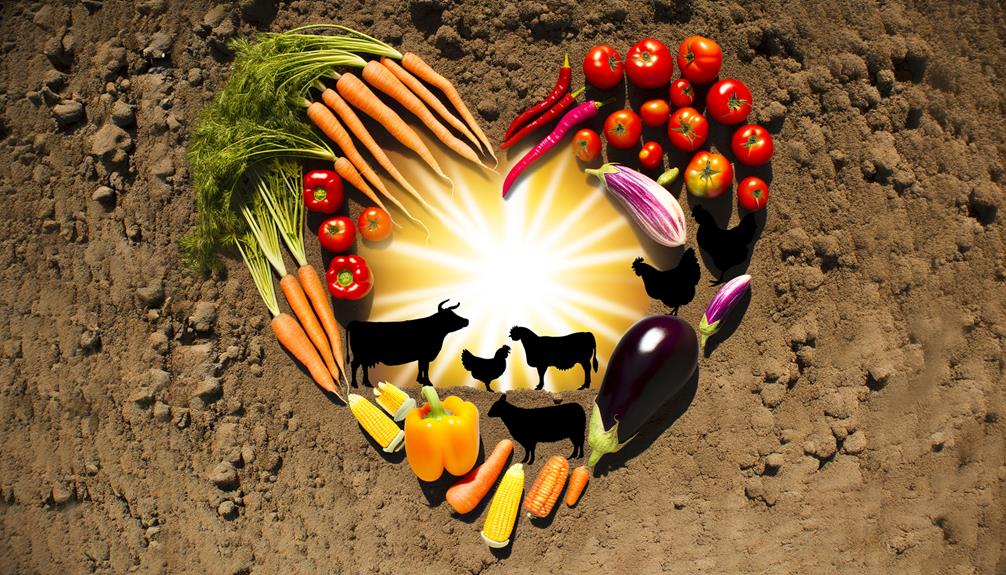You’ve just stumbled upon the greatest act of kindness you can offer to the animal kingdom: shifting to a cruelty-free diet. Imagine, with every meal, you could take a stand against animal suffering, championing their rights with the simple choice of what’s on your plate. It’s a journey that requires not just a change in what you eat, but a transformation in how you perceive the interconnection between your lifestyle and the well-being of sentient beings. As you consider removing meat and animal byproducts from your life, you’ll find that this is more than a diet; it’s an awakening to a more compassionate and sustainable way of living. The path isn’t always straightforward—you’ll face challenges such as finding alternatives that satisfy your palate and align with your values, and you’ll navigate the complexities of a world that hasn’t fully embraced this ethos. Yet, the rewards, both ethically and health-wise, can be immense. Stick with me, and let’s explore how this powerful choice can redefine not only your health but also the future of animal welfare.
Key Takeaways
- Transitioning to a plant-based diet involves a holistic approach and careful scrutiny of labels, as well as avoiding animal-tested products and making conscious choices in every purchase.
- Starting with plant-based basics such as stocking pantry with staples like beans, grains, tofu, and nuts, switching to plant-based milk and natural sweeteners, and integrating plant-based meat alternatives can help in the transition.
- A cruelty-free kitchen makeover involves eliminating animal products from the pantry, choosing cruelty-free brands and ingredients, educating oneself about hidden animal byproducts, and contributing to a cruelty-free society with every meal.
- Navigating social situations as a cruelty-free eater involves informing hosts about dietary preferences, suggesting restaurants with vegan options, bringing a cruelty-free dish to share, educating others about animal rights and health reasons, and maintaining social bonds while honoring commitment.
Understanding Vegan Principles
To truly embrace a vegan lifestyle, you’ll need to understand that it’s not just about what you eat; it’s a comprehensive commitment to cruelty-free choices in every aspect of your life. It’s a profound respect for animal welfare, a stance against animal cruelty, and a journey towards compassionate living.
Adopting vegan principles means you’ll transition to plant-based diets, which is more than just incorporating plant-based ingredients into your meals. It’s about a holistic approach to plant-based eating, ensuring that every bite you take supports the Treatment of Animals with kindness and consideration.
But it doesn’t stop with food. Your clothing, personal care items, and everyday products must align with cruelty-free practices. This involves careful scrutiny of labels, as you’ll want to avoid anything tested on animals or containing traces of animal sources. It’s a conscious choice that reflects your values in every purchase you make.
Starting With Plant-Based Basics
Having grasped the vegan principles for a kinder lifestyle, let’s explore the plant-based basics that form the foundation of your cruelty-free diet. Transitioning to a plant-based diet means you’ll be embracing foods that are not only kind to animals but also beneficial for your health. Start by stocking your pantry with staples like beans, grains, tofu, and nuts. These essentials are versatile, nutritious, and help you move away from animal products with ease.
Switching to plant-based options like almond or oat milk, and natural sweeteners, also contributes to a diet free from the cruelty associated with factory farms. By doing so, you’re not just opting out of animal agriculture, but you’re also taking a stand for the Treatment of Animals and nurturing your body with wholesome, healthful foods.
Integrating plant-based meat alternatives into your meals can make the change more approachable without sacrificing flavors you enjoy. Remember, every choice you make has an impact. By choosing products that align with your values of compassion and service to others, you’re fostering a more ethical and sustainable world. Start simple, be patient with your journey, and let your plate reflect the change you wish to see.
Cruelty-Free Kitchen Makeover
Embracing a cruelty-free lifestyle extends beyond your plate, beginning with a thoughtful revamp of your kitchen to ensure every ingredient aligns with your compassionate values. It’s about making choices that help animals and oppose the inhumane Treatment of Animals. Your cruelty-free kitchen makeover is a powerful statement against animal-based diets and products tested on animals.
Here’s how you can transform your kitchen:
- Eliminate Animal Products: Switch to a Vegan pantry by removing meat, dairy, and eggs. Look for plant-based alternatives that don’t compromise on taste or nutrition.
- Choose Cruelty-Free Brands: Opt for products and ingredients that are certified cruelty-free, ensuring they haven’t been subjected to animal testing.
- Mind the Labels: Educate yourself about hidden animal byproducts and choose items that respect animal rights.
This journey is both an educative process and an opportunity to advocate for a kinder world. By choosing cruelty-free, you’re not only safeguarding your health but also contributing to a movement that values the ethical Treatment of Animals. Every item you select sends a message of compassion, and with every meal, you’re actively working to help animals and promote a cruelty-free society.
When you’re dedicated to a cruelty-free lifestyle, social situations can pose unique challenges, but clear communication and a bit of planning can ensure you stay true to your values while enjoying time with others. It’s about balancing respect for animal rights with the social aspects of eating, often central to our interactions.
Before attending a gathering, let your host know about your dietary preferences. This isn’t just good for animals; it helps us foster understanding and encourages inclusive environments. Suggesting restaurants with vegan options or bringing a cruelty-free dish to share not only guarantees you’ll have something to eat but also introduces friends to tasty, compassionate choices.
You’ll find that many people are curious about your lifestyle. Embrace these moments to educate on the Treatment of Animals and health reasons behind your choices, all without casting judgment. Your passion can inspire others to consider the impact of meat on animals and our planet.
And remember, you can always eat beforehand if you’re unsure about the menu. This ensures you can focus on the company and conversation, rather than the food, maintaining social bonds while honoring your commitment to a cruelty-free diet.
Maintaining Commitment Long-Term
While navigating social situations is an important part of a cruelty-free lifestyle, it’s equally crucial to focus on strategies that will help you maintain your commitment in the long run. Understanding the profound benefits of a cruelty-free diet not only supports animal rights but also promotes positive health outcomes. You’re likely to experience lower risks of high blood pressure and heart disease, which are common concerns in today’s world.
Remember, your choices significantly contribute to reducing greenhouse gas emissions and slowing climate change. By choosing a lifestyle that respects the Treatment of Animals and the environment, you’re part of a compassionate movement dedicated to making the world a better place for all living beings.
To help you stay the course, consider these essential tips:
- Educate Yourself: Continually learn about the impacts of your diet choices on health, animals, and the environment.
- Connect with Community: Engage with like-minded individuals who share your passion for a cruelty-free world.
- Set Achievable Goals: Break down your journey into manageable steps to prevent feeling overwhelmed.
Maintaining commitment long-term involves a blend of personal resolve and community support. Keep exploring new cruelty-free options and recipes, and remind yourself of the positive difference you’re making. Your dedication serves as a beacon of hope and change.
Frequently Asked Questions
Is It Possible to Care About Animal Rights and Still Eat Meat?
You can respect animal rights and eat meat if you practice ethical omnivorism, making compassionate choices that minimize harm. Yet, this meat paradox often leads to moral dissonance and challenges dietary ethics.
Does Veganism Actually Save Animals?
Embracing veganism isn’t just planting seeds of kindness; it’s harvesting lives saved. Your dietary choices foster compassionate living, with every plant-based meal striking a blow against the meat industry for animal welfare.
What Is the Cruelty-Free Animal Policy?
The cruelty-free animal policy prioritizes ethical sourcing and compassionate choices, ensuring animal welfare through dietary ethics. It advocates for humane farming, conscious consumption, and high welfare standards to minimize lifestyle impact on animals.
Can You Be Against Animal Cruelty and Still Eat Meat?
You can care deeply about animal welfare and still eat meat, but it’s crucial to consider ethical omnivorism, humane farming, and conscious consumption to align your diet with your personal values against cruelty.







